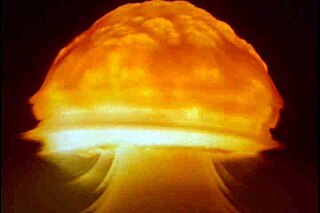Related Research Articles

Nuclear weapon designs are physical, chemical, and engineering arrangements that cause the physics package of a nuclear weapon to detonate. There are three existing basic design types:

In nuclear engineering, a neutron moderator is a medium that reduces the speed of fast neutrons, ideally without capturing any, leaving them as thermal neutrons with only minimal (thermal) kinetic energy. These thermal neutrons are immensely more susceptible than fast neutrons to propagate a nuclear chain reaction of uranium-235 or other fissile isotope by colliding with their atomic nucleus.

Operation Ivy was the eighth series of American nuclear tests, coming after Tumbler-Snapper and before Upshot–Knothole. The two explosions were staged in late 1952 at Enewetak Atoll in the Pacific Proving Ground in the Marshall Islands.

Operation Castle was a United States series of high-yield (high-energy) nuclear tests by Joint Task Force 7 (JTF-7) at Bikini Atoll beginning in March 1954. It followed Operation Upshot–Knothole and preceded Operation Teapot.

Operation Greenhouse was the fifth American nuclear test series, the second conducted in 1951 and the first to test principles that would lead to developing thermonuclear weapons. Conducted at the new Pacific Proving Ground, on islands of the Enewetak Atoll, it mounted the devices on large steel towers to simulate air bursts. This series of nuclear weapons tests was preceded by Operation Ranger and succeeded by Operation Buster-Jangle.

Operation Upshot–Knothole was a series of eleven nuclear test shots conducted in 1953 at the Nevada Test Site. It followed Operation Ivy and preceded Operation Castle.

Castle Bravo was the first in a series of high-yield thermonuclear weapon design tests conducted by the United States at Bikini Atoll, Marshall Islands, as part of Operation Castle. Detonated on March 1, 1954, the device was the most powerful nuclear device detonated by the United States and its first lithium deuteride fueled thermonuclear weapon. Castle Bravo's yield was 15 megatonnes of TNT (63 PJ), 2.5 times the predicted 6 megatonnes of TNT (25 PJ), due to unforeseen additional reactions involving lithium-7, which led to the unexpected radioactive contamination of areas to the east of Bikini Atoll. At the time, it was the most powerful artificial explosion in history.

Operation Plumbbob was a series of nuclear tests that were conducted between May 28 and October 7, 1957, at the Nevada Test Site, following Project 57, and preceding Project 58/58A.
Variable yield, or dial-a-yield, is an option available on most modern nuclear weapons. It allows the operator to specify a weapon's yield, or explosive power, allowing a single design to be used in different situations. For example, the Mod-10 B61 bomb had selectable explosive yields of 0.3, 5, 10 or 80 kilotons, depending on how the ground crew set a dial inside the casing when it was loaded onto an aircraft.

A boosted fission weapon usually refers to a type of nuclear bomb that uses a small amount of fusion fuel to increase the rate, and thus yield, of a fission reaction. The neutrons released by the fusion reactions add to the neutrons released due to fission, allowing for more neutron-induced fission reactions to take place. The rate of fission is thereby greatly increased such that much more of the fissile material is able to undergo fission before the core explosively disassembles. The fusion process itself adds only a small amount of energy to the process, perhaps 1%.

Gun-type fission weapons are fission-based nuclear weapons whose design assembles their fissile material into a supercritical mass by the use of the "gun" method: shooting one piece of sub-critical material into another. Although this is sometimes pictured as two sub-critical hemispheres driven together to make a supercritical sphere, typically a hollow projectile is shot onto a spike which fills the hole in its center. Its name is a reference to the fact that it is shooting the material through an artillery barrel as if it were a projectile.
The Tsetse was a small American nuclear bomb developed in the 1950s that was used as the primary in several US thermonuclear bombs and as a small stand-alone weapon of its own.
Kinglet was a boosted fission primary used in several American thermonuclear weapons.

Greenhouse Item was an American nuclear test conducted on May 25, 1951, as part of Operation Greenhouse at the Pacific Proving Ground, specifically on the island of Engebi in the Eniwetok Atoll in the Central Pacific Ocean. This test explosion was the first test of a boosted fission weapon.
The Mark 22 nuclear bomb (Mk-22) was the first thermonuclear device test by the University of California Radiation Lab (UCRL). The test was part of the Koon shot of Operation Castle. The Mk-22 failed to achieve anything like its intended yield due to premature heating of the secondary from exposure to neutrons. As the other UCRL test planned for the Castle series, the liquid-fueled "Ramrod" device had the same basic design flaw, that test was canceled. Within a month of the bomb's failure, the Mk-22 was terminated because the United States Atomic Energy Commission realized there was nothing that could be done to salvage the design.
The Koon shot of Operation Castle was a test of a thermonuclear device designed at the University of California Radiation Laboratory (UCRL), now Lawrence Livermore National Laboratory (LLNL).

The uranium hydride bomb was a variant design of the atomic bomb first suggested by Robert Oppenheimer in 1939 and advocated and tested by Edward Teller. It used deuterium, an isotope of hydrogen, as a neutron moderator in a uranium-deuterium ceramic compact. Unlike all other fission-based weapon types, the concept relies on a chain reaction of slow nuclear fission. Bomb efficiency was adversely affected by the cooling of neutrons since the latter delays the reaction, as delineated by Rob Serber in his 1992 extension of the original Los Alamos Primer.

A fizzle occurs when the detonation of a device for creating a nuclear explosion grossly fails to meet its expected yield. The bombs still detonate, however, the detonation is much less than anticipated. The cause(s) for the failure can be linked to improper design, poor construction, or lack of expertise. All countries that have had a nuclear weapons testing program have experienced some fizzles. A fizzle can spread radioactive material throughout the surrounding area, involve a partial fission reaction of the fissile material, or both. For practical purposes, a fizzle can still have considerable explosive yield when compared to conventional weapons.

Upshot–Knothole Harry (UK#9) was a nuclear weapons test conducted by the United States as part of Operation Upshot–Knothole. It took place at the recorded time of 04:05 hours, on May 19th, 1953 in Yucca Flat, in the Nevada Test Site. The sponsor of the test was the National Laboratory of the United States of America located at Los Alamos.

Operation Dominic was a series of 31 nuclear test explosions with a 38.1 Mt (159 PJ) total yield conducted in 1962 by the United States in the Pacific. This test series was scheduled quickly, in order to respond in kind to the Soviet resumption of testing after the tacit 1958–1961 test moratorium. Most of these shots were conducted with free fall bombs dropped from B-52 bomber aircraft. Twenty of these shots were to test new weapons designs; six to test weapons effects; and several shots to confirm the reliability of existing weapons. The Thor missile was also used to lift warheads into near-space to conduct high-altitude nuclear explosion tests; these shots were collectively called Operation Fishbowl.
References
- ↑ Hansen, Chuck (1995). Swords of Armageddon. Vol. IV. Retrieved 2016-12-28.
- 1 2 3 4 5 6 7 8 Hansen, Chuck (1995). Swords of Armageddon. Vol. III. Retrieved 2016-12-28.
- 1 2 "The Nuclear Weapon Archive - A Guide to Nuclear Weapons" . Retrieved 23 September 2017.
- 1 2 Hansen, Chuck (1995). Swords of Armageddon. Vol. II. Retrieved 2016-12-28.
- ↑ United States Nuclear Weapons. Globalsecurity.org. Retrieved on 2018-02-08.
- ↑ Hansen, Chuck (2007). The Swords of Armageddon: U.S. Nuclear Weapons Development Since 1945 (PDF) (CD-ROM & download available) (2 ed.). Sunnyvale, California: Chuklea Publications. ISBN 978-0-9791915-0-3.